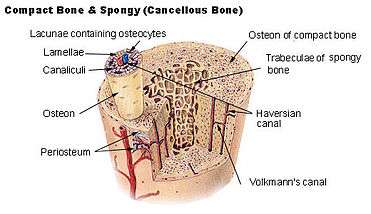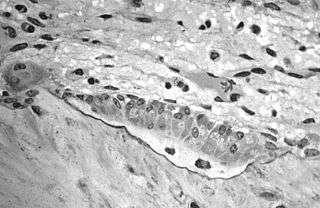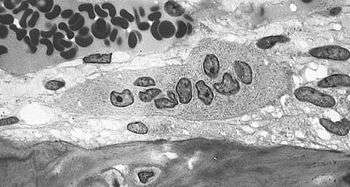Bone tissue
| Bone tissue | |
|---|---|
 | |
Bone tissue, or osseous tissue, is the major structural and supportive connective tissue of the body. Bone tissue forms the rigid part of the bones that make up the skeleton.
Bones are organs that are made up of bone tissue as well as bone marrow, small blood vessels, epithelium and nerves. Bone tissue refers specifically to the bone mineral matrix that forms the rigid sections of the organ, and the bone cells within it. The two types of bone tissue are cortical bone and cancellous bone.
Structure
There are two types of bone tissue: cortical bone and cancellous bone. Cortical bone is synonymous with compact bone, and cancellous bone is synonymous with trabecular and spongy bone. Cortical bone forms the extremely hard exterior while cancellous bone fills the hollow interior. The tissues are biologically identical; the difference is in how the microstructure is arranged.
Formation
Bone tissue is a mineralized connective tissue. It is formed by cells, called osteoblasts, that deposit a matrix of Type-I collagen and also release calcium, magnesium, and phosphate ions that ultimately combine chemically within the collagenous matrix into a crystalline mineral, known as bone mineral, in the form of carbonated hydroxyapatite. The combination of hard mineral and flexible collagen makes bone harder and stronger than cartilage without being brittle. Cortical bone consists of a repeating structure called an osteon or haversian system, which is the primary anatomical and functional unit. Each osteon has concentric lamellae (layers) of mineralized matrix, which are deposited around a central canal, known as the haversian canal, each containing blood and nerve supply.
pH balance
Various body systems, including the urinary, respiratory and skeletal systems, interact to maintain the body's proper pH levels. Certain conditions, such as kidney disease, cause an imbalance and lowering of pH levels due to the build-up of H+ ions in the blood. In response to the acidic conditions, bone tissue will dissolve to release calcium carbonate into the bloodstream. The carbonate ions act to neutralize some of the acidity of the blood. However, the loss of calcium carbonate can lead to osteomalacia, the softening of the bones due to the inability to properly construct new bone. With osteomalacia, there is a higher risk for breaks and fractures, similar to osteoporosis.[1][2]



Function
Bone tissue performs numerous functions including:
Directly:
- Support for muscles, organs, and soft tissues.
- Leverage and movement.
- Protection of vital organs, e.g., the heart. (Note: not all vital organs are protected by bones, e.g., the intestines.)
- Calcium phosphate storage.
Indirectly:
- Hemopoiesis - formation of blood cells by the bone marrow interspersed within the spongy bone.
See also
- Biomaterials: Mechanical Properties
- Periosteum
- Bone healing
- Osseointegration
- Osteocyte
- Osteoclast
- Biomaterials: Mechanical Properties
References
- ↑ "Osteomalacia". Mayo Clinic. Mayo Foundation for Medical Education and Research.
- ↑ Saladin, Kenneth (2012). Anatomy and Physiology: The Unity of Form and Function. McGraw Hill. p. 221. ISBN 9780073378251.
Sources
- Henry Gray: Anatomy of the human body (Bartleby.com; Great Books Online)
- Eldra P. Solomon - Richard R. Schmidt - Peter J. Adragna : Human anatomy & physiology ed. 2nd 1990 (Sunders College Publishing, Philadelphia) ISBN 0-03-011914-6